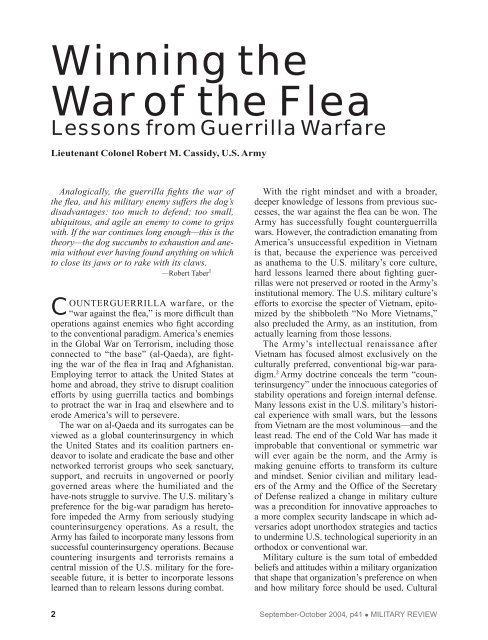Counterinsurgency Reader - Combined Arms Center - U.S. Army
Counterinsurgency Reader - Combined Arms Center - U.S. Army
Counterinsurgency Reader - Combined Arms Center - U.S. Army
You also want an ePaper? Increase the reach of your titles
YUMPU automatically turns print PDFs into web optimized ePapers that Google loves.
Winning the<br />
War of the Flea<br />
Lessons from Guerrilla Warfare<br />
Lieutenant Colonel Robert M. Cassidy, U.S. <strong>Army</strong><br />
Analogically, the guerrilla fights the war of<br />
the flea, and his military enemy suffers the dog’s<br />
disadvantages: too much to defend; too small,<br />
ubiquitous, and agile an enemy to come to grips<br />
with. If the war continues long enough—this is the<br />
theory—the dog succumbs to exhaustion and anemia<br />
without ever having found anything on which<br />
to close its jaws or to rake with its claws.<br />
—Robert Taber 1<br />
Counterguerrilla warfare, or the<br />
“war against the flea,” is more difficult than<br />
operations against enemies who fight according<br />
to the conventional paradigm. America’s enemies<br />
in the Global War on Terrorism, including those<br />
connected to “the base” (al-Qaeda), are fighting<br />
the war of the flea in Iraq and Afghanistan.<br />
Employing terror to attack the United States at<br />
home and abroad, they strive to disrupt coalition<br />
efforts by using guerrilla tactics and bombings<br />
to protract the war in Iraq and elsewhere and to<br />
erode America’s will to persevere.<br />
The war on al-Qaeda and its surrogates can be<br />
viewed as a global counterinsurgency in which<br />
the United States and its coalition partners endeavor<br />
to isolate and eradicate the base and other<br />
networked terrorist groups who seek sanctuary,<br />
support, and recruits in ungoverned or poorly<br />
governed areas where the humiliated and the<br />
have-nots struggle to survive. The U.S. military’s<br />
preference for the big-war paradigm has heretofore<br />
impeded the <strong>Army</strong> from seriously studying<br />
counterinsurgency operations. As a result, the<br />
<strong>Army</strong> has failed to incorporate many lessons from<br />
successful counterinsurgency operations. Because<br />
countering insurgents and terrorists remains a<br />
central mission of the U.S. military for the foreseeable<br />
future, it is better to incorporate lessons<br />
learned than to relearn lessons during combat.<br />
With the right mindset and with a broader,<br />
deeper knowledge of lessons from previous successes,<br />
the war against the flea can be won. The<br />
<strong>Army</strong> has successfully fought counterguerrilla<br />
wars. However, the contradiction emanating from<br />
America’s unsuccessful expedition in Vietnam<br />
is that, because the experience was perceived<br />
as anathema to the U.S. military’s core culture,<br />
hard lessons learned there about fighting guerrillas<br />
were not preserved or rooted in the <strong>Army</strong>’s<br />
institutional memory. The U.S. military culture’s<br />
efforts to exorcise the specter of Vietnam, epitomized<br />
by the shibboleth “No More Vietnams,”<br />
also precluded the <strong>Army</strong>, as an institution, from<br />
actually learning from those lessons.<br />
The <strong>Army</strong>’s intellectual renaissance after<br />
Vietnam has focused almost exclusively on the<br />
culturally preferred, conventional big-war paradigm.<br />
2 <strong>Army</strong> doctrine conceals the term “counterinsurgency”<br />
under the innocuous categories of<br />
stability operations and foreign internal defense.<br />
Many lessons exist in the U.S. military’s historical<br />
experience with small wars, but the lessons<br />
from Vietnam are the most voluminous—and the<br />
least read. The end of the Cold War has made it<br />
improbable that conventional or symmetric war<br />
will ever again be the norm, and the <strong>Army</strong> is<br />
making genuine efforts to transform its culture<br />
and mindset. Senior civilian and military leaders<br />
of the <strong>Army</strong> and the Office of the Secretary<br />
of Defense realized a change in military culture<br />
was a precondition for innovative approaches to<br />
a more complex security landscape in which adversaries<br />
adopt unorthodox strategies and tactics<br />
to undermine U.S. technological superiority in an<br />
orthodox or conventional war.<br />
Military culture is the sum total of embedded<br />
beliefs and attitudes within a military organization<br />
that shape that organization’s preference on when<br />
and how military force should be used. Cultural<br />
<br />
September-October 2004, p41 • Military Review

















